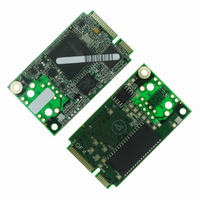20-101-1306 Rabbit Semiconductor, 20-101-1306 Datasheet - Page 92

20-101-1306
Manufacturer Part Number
20-101-1306
Description
CORE MODULE RCM5750
Manufacturer
Rabbit Semiconductor
Type
Serial to Ethernetr
Datasheet
1.20-101-1306.pdf
(119 pages)
Specifications of 20-101-1306
Module/board Type
MPU Core Module
Number Of I/os
32
Ethernet Connection Type
10/100 Base-T
Memory Type
Flash
Operating Voltage
3.3 V
Operating Current
70 mA
Operating Temperature Range
- 40 C to + 85 C
Board Size
30 mm x 51 mm x 3 mm
Product
Modules
For Use With/related Products
RCM5750
Lead Free Status / RoHS Status
Lead free / RoHS Compliant
Other names
316-1183
F.2 TCP/IP Primer on IP Addresses
Obtaining IP addresses to interact over an existing, operating, network can involve a number of
complications, and must usually be done with cooperation from your ISP and/or network systems
administrator. For this reason, it is suggested that the user begin instead by using a direct connec-
tion between a PC and the Interface Board using a CAT 4/5 Ethernet cable or a simple arrange-
ment with a hub.
In order to set up this direct connection, the user will have to use a PC without networking, or dis-
connect a PC from the corporate network, or install a second Ethernet adapter and set up a sepa-
rate private network attached to the second Ethernet adapter. Disconnecting your PC from the
corporate network may be easy or nearly impossible, depending on how it is set up. If your PC
boots from the network or is dependent on the network for some or all of its disks, then it probably
should not be disconnected. If a second Ethernet adapter is used, be aware that Windows TCP/IP
will send messages to one adapter or the other, depending on the IP address and the binding order
in Microsoft products. Thus you should have different ranges of IP addresses on your private net-
work from those used on the corporate network. If both networks service the same IP address,
then Windows may send a packet intended for your private network to the corporate network. A
similar situation will take place if you use a dial-up line to send a packet to the Internet. Windows
may try to send it via the local Ethernet network if it is also valid for that network.
The following IP addresses are set aside for local networks and are not allowed on the Internet:
10.0.0.0 to 10.255.255.255, 172.16.0.0 to 172.31.255.255, and 192.168.0.0 to 192.168.255.255.
The Interface Board uses a 10/100Base-T type of Ethernet connection, which is the most common
scheme. The RJ-45 connectors are similar to U.S. style telephone connectors, except they are
larger and have 8 contacts.
An alternative to the direct connection using a CAT 4/5 Ethernet cable is a direct connection using
a hub. The hub relays packets received on any port to all of the ports on the hub. Hubs are low in
cost and are readily available. The RCM5700/RCM6700 uses 10/100Mps Ethernet, so the hub or
Ethernet adapter can be a 10 Mbps unit or a 10/100 Mbps unit.
In a corporate setting where the Internet is brought in via a high-speed line, there are typically
machines between the outside Internet and the internal network. These machines include a combi-
nation of proxy servers and firewalls that filter and multiplex Internet traffic. In the configuration
below, the MiniCore could be given a fixed address so any of the computers on the local network
would be able to contact it. It may be possible to configure the firewall or proxy server to allow
hosts on the Internet to directly contact the controller, but it would probably be easier to place the
controller directly on the external network outside of the firewall. This avoids some of the config-
uration complications by sacrificing some security.
rabbit.com
MiniCore RCM5700/RCM6700 User’s Manual
92

















